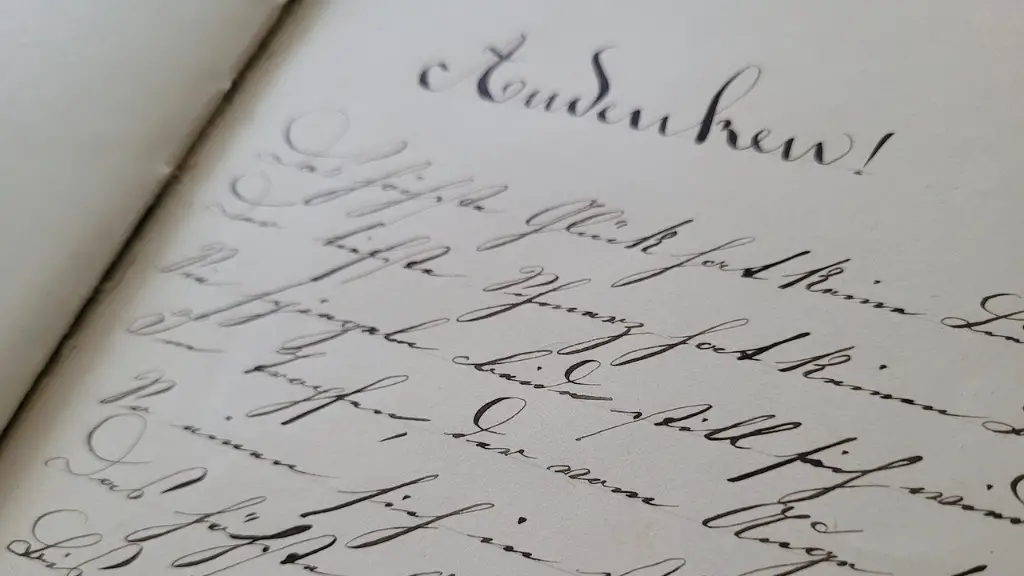Definition of a Sound Device in Poetry
In poetry, a sound device is a literary element used to emphasize meaning and musicality. Sound devices are tools poets use to create rhythm, reinforce meaning and draw attention to selected words or phrases. Sound devices include the use of repetition, assonance and consonance among many others.
Importance of Sound Devices
The importance of sound devices in poetry lies in their ability to enhance the sound and meaning of a poem. Through its sound as well as its visual appearance on the page, the structure of a poem can be altered and made more or less memorable. Increasing the musicality of a poem with sound devices can also serve as a form of creative expression and may help to convey a particular idea or emotion to the reader.
Types of Sound Devices in Poetry
One type of poetic sound device is assonance, which is the repeating of vowel sounds in words close to each other. Another type is consonance, which is the repetition of consonant sounds in words close to each other. Repetition is a sound device in which a word or phrase is repeated multiple times for emphasis. Alliteration is the repetition of beginning sounds in words close to each other and onomatopoeia is the use of words that imitate sounds to create a vivid image in the reader’s mind. Rhyme is a repetition of similar or identical sounds at the ends of the lines.
Effects of Sound Devices
The effects of sound devices in poetry can vary depending on how they are used. Repetition and strong rhyme schemes undoubtedly increase the musicality of a poem and emphasize one or more ideas or feelings. Assonance and various forms of repetition can help to create a mood or atmosphere throughout a poem,while alliteration can draw attention to certain words or phrases. Onomatopoeia can create a sense of movement or action and is often used to evoke a particular emotion in the audience.
Application of Sound Devices
Sound devices can be applied to any poetry and the results are often quite effective. Poets may experiment with alliteration, assonance and rhyme to create different sounds and evoke different emotions in the reader. Repetition, in particular, can be used to emphasize key words or phrases and to create a sense of unity within a poem. When used correctly, sound devices can really bring a poem to life and help to express complex ideas and feelings in a meaningful and creative way.
Importance of Context and Word Choice
The context and word choice in a poem are essential when it comes to the use of sound devices. The words chosen and how they are arranged must be carefully considered if the desired effect is to be achieved. It is also important to consider the context in which the poem is being written. Different sound devices may be more effective for different writing styles, moods, and subject matters.
Sound Devices in Relation to Other Literary Devices
Sound devices can be used in conjunction with other literary devices in order to create a desired effect. Alliteration, for example, can be used in combination with metaphor to draw attention to a certain phrase or idea. Sound devices can be used to highlight certain words or phrases in a poem and to reinforce the desired message or feeling.
Exploring the Use of Sound Devices
Exploring the use of sound devices in poetry can be a great way to enhance a poem’s musicality and to express complex and emotional concepts. Poets are encouraged to experiment with different sound devices and to be creative in the way they are used. The use of sound devices in poetry can help to add depth to a poem and bring it to life in an expressive and meaningful way.
How Sound Devices are Used in Poetry for Effect
In poetry the use of sound devices serves many purposes. They can be used to establish a particular atmosphere, draw attention to certain words, or to emphasize important ideas. When used effectively, sound devices can engage and move the reader, helping to create powerful and vivid images in the reader’s mind. By experimenting with different sound devices, poets can achieve amazing effects in their writing and develop their creative expression.
Evidence of Sound Device Use in Popular Poetry
The use of sound devices in poetry is evident in many popular works of poetry. For example, in Robert Frost’s poem “The Road Not Taken”, alliteration is used to draw attention to certain words and phrases throughout the poem. Similarly, in William Wordsworth’s poem “Daffodils”, repetition is used to emphasize certain words and ideas, creating a memorable and powerful poem. Sound devices are also commonly used in rap songs, as many rap artists use repetition, assonance and alliteration to create compelling and emotionally-charged verses.
The Impact of Sound Devices on Poems
The impact of sound devices on poems can be profound. By using these devices, poets can breathe life into their work and create a more immersive and powerful experience for the reader. Repeated use of sound devices can also add a sense of unity to a poem and help to emphasize certain ideas and emotions. The careful use of sound devices can significantly improve the musicality of a poem, captivating and engaging the reader.


